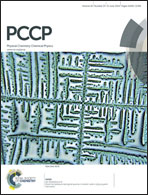Cobalt porphyrin electrode films for electrocatalytic water oxidation†
Abstract
Catalysts play very important roles in artificial photosynthesis for solar energy conversion. In this present study, two water-insoluble cobalt porphyrin complexes, cobalt(II) meso-tetraphenylporphyrin (CoP-1) and cobalt(II) 5,10,15,20-tetrakis-(4-bromophenyl)porphyrin (CoP-2), were synthesized and coated as thin films on the FTO working electrode. The films showed good activities for electrocatalytic water oxidation in aqueous solutions at pH 9.2. The Faradaic efficiencies of both films approached to ∼100%, measured using a fluorescence-based oxygen sensor. The turnover frequencies were close to 0.50 s−1 and 0.40 s−1 for CoP-1 and CoP-2, respectively, under an applied anodic potential of 1.3 V (vs. Ag/AgCl) at pH 9.2. Importantly, no cobalt oxide particles were observed on the working electrode after catalysis. The stability of the catalyst films was further evaluated by UV-vis spectroscopy, inhibition measurements, mass spectrometry, scanning electron microscopy (SEM) and energy dispersive X-ray spectroscopy (EDX). The pH dependence of water oxidation on CoP-1 and CoP-2 suggested a proton-coupled electron transfer (PCET) mechanism. The catalyst films could be recycled and showed almost unchanged catalytic activities when they were reused in new electrocatalytic studies of water oxidation.


 Please wait while we load your content...
Please wait while we load your content...